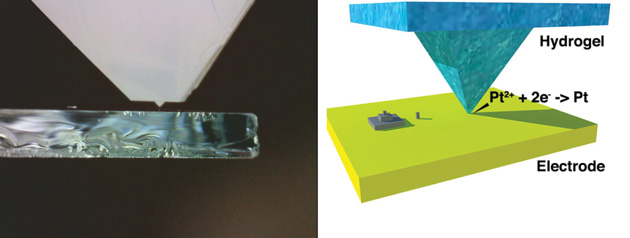A pen that performs 3D printing on the nanoscale has been developed by scientists in South Korea.
The pen, created by Seongpil Hwang of Korea University and co-workers, amalgamates the precision of atomic force microscopy with a diffusion limited current from a microscopic electrode.

Contact between the pen's tip and a working electrode creates a localised electroactive area for precise electrodeposition
At its tip, the pen has a microscopic hydrogel pyramid, the sharp apex of which is soaked in an electrolyte for electrochemical reactions. A nanometre-scale area for reactant mass transport results from contact between this tip and an ultramicroelectrode. Controlling this contact with a nanopositioning system regulates a faradaic reaction that enables electroplating to give precise nanostructures; in this case 3D structures of platinum were deposited on a gold electrode – some with dimensions less than 100nm.
To read the full article visit the Chemistry World website.
The paper is free to read in Nanoscale until 13 January 2015:
Hydrogel Pen for Electrochemical Reaction and Its Applications for 3D Printing
Hosuk Kang, Seongpil Hwang and Juhyoun Kwak, Nanoscale, 2015, DOI: 10.1039/C4NR06041E










